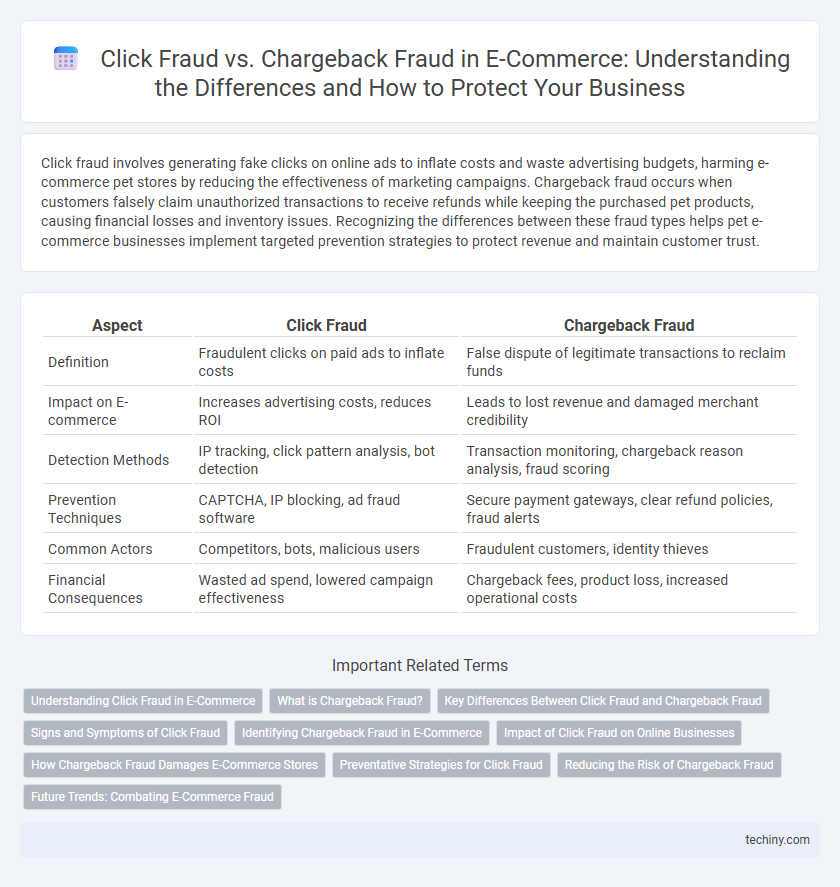Click fraud involves generating fake clicks on online ads to inflate costs and waste advertising budgets, harming e-commerce pet stores by reducing the effectiveness of marketing campaigns. Chargeback fraud occurs when customers falsely claim unauthorized transactions to receive refunds while keeping the purchased pet products, causing financial losses and inventory issues. Recognizing the differences between these fraud types helps pet e-commerce businesses implement targeted prevention strategies to protect revenue and maintain customer trust.
Table of Comparison
| Aspect | Click Fraud | Chargeback Fraud |
|---|---|---|
| Definition | Fraudulent clicks on paid ads to inflate costs | False dispute of legitimate transactions to reclaim funds |
| Impact on E-commerce | Increases advertising costs, reduces ROI | Leads to lost revenue and damaged merchant credibility |
| Detection Methods | IP tracking, click pattern analysis, bot detection | Transaction monitoring, chargeback reason analysis, fraud scoring |
| Prevention Techniques | CAPTCHA, IP blocking, ad fraud software | Secure payment gateways, clear refund policies, fraud alerts |
| Common Actors | Competitors, bots, malicious users | Fraudulent customers, identity thieves |
| Financial Consequences | Wasted ad spend, lowered campaign effectiveness | Chargeback fees, product loss, increased operational costs |
Understanding Click Fraud in E-Commerce
Click fraud in e-commerce involves fraudulent clicks on online ads, artificially inflating pay-per-click (PPC) advertising costs and skewing campaign performance metrics. This type of fraud targets advertisers by generating invalid clicks through bots, competitors, or malicious users, leading to wasted ad spend and reduced return on investment (ROI). Detecting click fraud requires advanced analytics and machine learning algorithms to analyze click patterns, IP addresses, and user behavior to protect e-commerce businesses from financial losses.
What is Chargeback Fraud?
Chargeback fraud occurs when a customer makes a legitimate purchase online but then disputes the charge with their bank to receive a refund while retaining the product or service. This type of fraud results in financial losses for e-commerce merchants due to lost revenue, reversed transaction fees, and potential penalties from payment processors. Effective chargeback management and fraud detection tools are essential to mitigate risks and protect online businesses from such fraudulent disputes.
Key Differences Between Click Fraud and Chargeback Fraud
Click fraud involves artificially inflating pay-per-click advertising costs by generating fake clicks, whereas chargeback fraud occurs when a customer disputes a legitimate transaction to receive a refund while keeping the product or service. Click fraud primarily targets advertisers and digital marketing budgets, while chargeback fraud directly impacts merchant revenue and payment processing. Understanding these key differences enables e-commerce businesses to implement tailored fraud detection and prevention strategies specific to each threat.
Signs and Symptoms of Click Fraud
Click fraud in e-commerce is identified by unusually high click-through rates from suspicious IP addresses, rapid repetition of clicks on the same advertisement, and inconsistent user behavior patterns such as brief site visits with no conversions. These signs often result in inflated advertising costs without corresponding sales, indicating fraudulent manipulation of pay-per-click campaigns. Monitoring real-time analytics for abnormal click activity and implementing CAPTCHA solutions can help detect and mitigate click fraud efficiently.
Identifying Chargeback Fraud in E-Commerce
Chargeback fraud in e-commerce occurs when customers dispute legitimate transactions to reverse payments unfairly, causing financial losses for merchants. Identifying chargeback fraud involves monitoring unusual refund patterns, analyzing customer purchase history, and detecting discrepancies between transaction details and dispute reasons. Implementing fraud detection software and maintaining clear communication with payment processors can help mitigate risks and protect revenue.
Impact of Click Fraud on Online Businesses
Click fraud severely drains marketing budgets by generating false ad clicks, leading to inflated advertising costs without corresponding sales conversions. This fraudulent activity distorts valuable data analytics, impairing the ability of online businesses to accurately assess campaign effectiveness and optimize marketing strategies. As a result, companies face reduced ROI on digital ad spend, increased operational expenses, and diminished trust in advertising platforms.
How Chargeback Fraud Damages E-Commerce Stores
Chargeback fraud severely impacts e-commerce stores by depleting revenue through illegitimate refund claims, often after customers receive and use products. This type of fraud escalates operational costs due to increased chargeback fees and resource allocation for dispute resolution. Prolonged exposure to chargeback fraud can damage merchant reputation, increase payment processor scrutiny, and even lead to account termination.
Preventative Strategies for Click Fraud
Effective preventative strategies for click fraud in e-commerce include implementing advanced IP filtering and anomaly detection systems to identify and block suspicious click patterns. Utilizing machine learning algorithms helps analyze user behavior and distinguish genuine clicks from fraudulent activity, reducing ad spend waste. Regular audits of traffic sources and setting click limits per IP also minimize the risk of artificial click inflation.
Reducing the Risk of Chargeback Fraud
Implementing robust verification systems such as AVS (Address Verification System) and CVV checks significantly reduces the risk of chargeback fraud in e-commerce transactions. Leveraging machine learning algorithms to analyze transaction patterns helps identify and block suspicious activities before chargebacks occur. Collaborating with payment processors that offer advanced fraud detection and chargeback management tools further strengthens protection against financial losses due to fraudulent chargebacks.
Future Trends: Combating E-Commerce Fraud
Advancements in AI-powered analytics and machine learning models are revolutionizing the detection of click fraud and chargeback fraud in e-commerce, enabling real-time identification of suspicious transactions. Blockchain technology is emerging as a secure method to verify transaction authenticity and reduce fraudulent chargebacks by creating immutable records. Increasing collaboration between payment processors, e-commerce platforms, and cybersecurity firms is establishing stronger defense mechanisms to combat evolving fraud tactics effectively.
Click Fraud vs Chargeback Fraud Infographic

 techiny.com
techiny.com